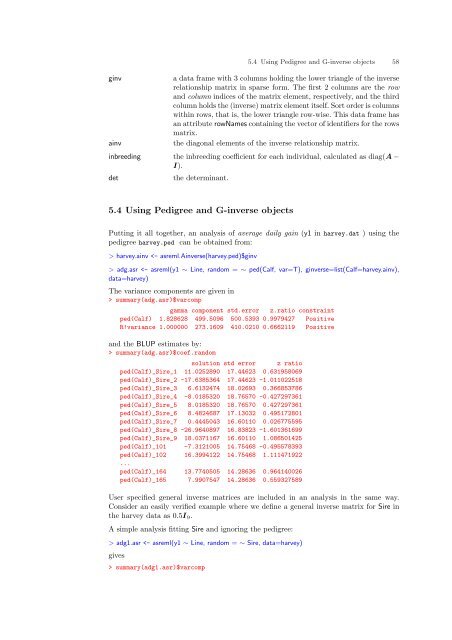ASReml-S reference manual - VSN International
ASReml-S reference manual - VSN International
ASReml-S reference manual - VSN International
- No tags were found...
Create successful ePaper yourself
Turn your PDF publications into a flip-book with our unique Google optimized e-Paper software.
5.4 Using Pedigree and G-inverse objects 58ginvainvinbreedingdeta data frame with 3 columns holding the lower triangle of the inverserelationship matrix in sparse form. The first 2 columns are the rowand column indices of the matrix element, respectively, and the thirdcolumn holds the (inverse) matrix element itself. Sort order is columnswithin rows, that is, the lower triangle row-wise. This data frame hasan attribute rowNames containing the vector of identifiers for the rowsmatrix.the diagonal elements of the inverse relationship matrix.the inbreeding coefficient for each individual, calculated as diag(A −I).the determinant.5.4 Using Pedigree and G-inverse objectsPutting it all together, an analysis of average daily gain (y1 in harvey.dat ) using thepedigree harvey.ped can be obtained from:> harvey.ainv adg.asr summary(adg.asr)$varcompgamma component std.error z.ratio constraintped(Calf) 1.828628 499.5096 500.5393 0.9979427 PositiveR!variance 1.000000 273.1609 410.0210 0.6662119 Positiveand the BLUP estimates by:> summary(adg.asr)$coef.randomsolution std error z ratioped(Calf)_Sire_1 11.0252890 17.44623 0.631958069ped(Calf)_Sire_2 -17.6385364 17.44623 -1.011022518ped(Calf)_Sire_3 6.6132474 18.02693 0.366853786ped(Calf)_Sire_4 -8.0185320 18.76570 -0.427297361ped(Calf)_Sire_5 8.0185320 18.76570 0.427297361ped(Calf)_Sire_6 8.4824687 17.13032 0.495172801ped(Calf)_Sire_7 0.4445043 16.60110 0.026775595ped(Calf)_Sire_8 -26.9640897 16.83823 -1.601361699ped(Calf)_Sire_9 18.0371167 16.60110 1.086501425ped(Calf)_101 -7.3121005 14.75468 -0.495578393ped(Calf)_102 16.3994122 14.75468 1.111471922...ped(Calf)_164 13.7740505 14.28636 0.964140026ped(Calf)_165 7.9907547 14.28636 0.559327589User specified general inverse matrices are included in an analysis in the same way.Consider an easily verified example where we define a general inverse matrix for Sire inthe harvey data as 0.5I 9 .A simple analysis fitting Sire and ignoring the pedigree:> adg1.asr summary(adg1.asr)$varcomp
















